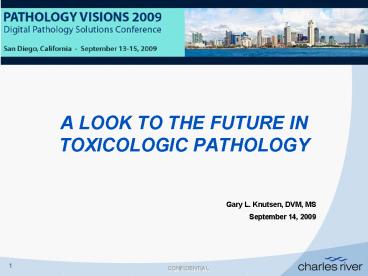A LOOK TO THE FUTURE IN TOXICOLOGIC PATHOLOGY - PowerPoint PPT Presentation
1 / 25
Title: A LOOK TO THE FUTURE IN TOXICOLOGIC PATHOLOGY
1
A LOOK TO THE FUTURE IN TOXICOLOGIC PATHOLOGY
- Gary L. Knutsen, DVM, MS
- September 14, 2009
2
A Look to the Future in Toxicologic Pathology
- Guest Editorial The Re-emergence (or the
Decline) of Toxicologic Pathology - Over the longer term, a strategy for reinvention
and renewal is needed in toxicologic pathology.
This reinvention will depend on the expansion of
the pathologist's "tool kit," as well as his or
her adaptability and willingness to accept
personal risk. Pathologists should be prepared to
deal with digital imaging and the use of genomics
and proteomics for diagnostic purposes and for
refinement of risk assessments. The toxicologic
pathologist of the future will not just be an
expert in morphologic disease processes through
the microscopic examination of animal tissues,
but also a molecular pathway analyst, an image
analyst, and an ex vivo (or in vitro)
diagnostician. He or she will need to be able to
confidently apply his or her knowledge and to
lead colleagues' understanding of the diverse
toxicology skill sets, so that they understand
and embrace his or her judgment in the
extrapolation of data in risk assessment. - Source Toxicologic Pathology, Vol 37 No. 5, 2009
- Author Dr. Carl L. Alden
- Editor in Chief, Toxicologic Pathology
(1996-1998) - Vice President, Drug Safety Evaluation,
Millennium Pharmaceuticals, Inc.
3
Challenges Facing Toxicologic Pathology
- Discouraging demographics dwindling number of
veteran glass pushing pathologists - Demand for increased, commoditized-like
productivity - Demand for increased objectivity to facilitate
decision making - Expanding tool kits equate to growing
requirements for high content pathology
practices to improve predictive toxicology - Mergers and acquisitions resulting in global
multi-site organizations generating internal
integration/harmonization challenges - Growth of Far East CRO and Pharma Industry where
today the toxicologic pathology discipline is
least represented
4
Digital Toxicologic Pathology Evolution
GLP ADOPTION
SAFETY TOXPATH (FULLY AUTOMATED) HistoQC HistoPAT
H HistoPATH DX - Specific Diagnostic
Determination
ADOPTION
DISCOVERY TOXPATH (FULLY AUTOMATED) Computer
Assisted Pathology System (CAPS) HistoQC Slide
Screening for quality and completeness HistoPATH
Normal vs.. Non-Normal Tissue Screening
CREDIBILITY
INVESTIGATIVE/MECHANISTIC and IHC TOXPATH
(SEMI-AUTOMATED) Aperio Genie and Image Analysis
Tool Box Bioimagene Virtuoso and Custom
Algorithm Solutions Definiens Tissue Studio and
Cognition Network Technology
VIABILITY
TELEPATHOLOGY (REMOTE VIEWING) Image Sharing
Consultation Virtual Peer Review Virtual
Pathology Working Groups
5
Yesterday and Today Telepathology
- Remote Intra-Company Consultation
- Remote toxpath Rounds
- Virtual slide conferencing
- Informal and Formal Peer Review
- Pathology Working Groups (PWGs)
FDA/NCTR NIEHS/NTP Interagency Agreement
(IAG) Pathology Working Group
6
Today and Tomorrow Semi Automated
Investigative/Mechanistic/IHC ToxPath Tools
7
Today and Tomorrow Fully Automated Computer
Assisted Pathology System (CAPS)
8
Proof of Concept Discovery/Lead Optimization
Study
CAPSTM HistoPATH Heatmap
9
Target Tissue Drill Down HISTOPATH
Determination of the Non Normal Livers
Detector Driven Findings
10
Detector Drill Down Individual/Treatment Group
Comparison Using Detector-driven Objective Data
Objective Measure of Specific Change
11
Preparing for Image Drill Down
Specific Animal Tissue Selection and Image
Comparison
12
Control Animal vs. Treated Animal Image Comparison
13
Control Animal Liver Image with Histogram
14
Full Screen Control vs. Treated Image
Comparison(Density of Hepatocyte Nuclei
Hepatocellular Hypertrophy)
15
Detection of Cellularity of Portals(Increased
Periportal Cellularity)
16
Detection of Area of Disrupted Tissue
(Coagulative Necrosis)
17
Detection of Area Affected by Multifocal Cellular
Infiltrate (Multifocal Cellular Infiltration)
18
Detection of Density of Diffuse Cellular
Infiltrates
19
Detection of Density of Mitotic Figures
20
Detection of Density of Vesiculation
(Hepatocellular Cytoplasmic Vacuolation)
21
The Future - CAPS Pathologists Cockpit
22
The Future Workstation In-a-Glance Snapshot of
Preliminary Study Results
- View the Heatmap and associated charts and
imagesand minutes later - Identify behavior of study controls vs.
historical normals - Confirm Computer-determined target tissues
(identify targets for lower dose histology
preparation) - Identify the specific detection results and
corresponding tissue changes and their magnitude - Preliminary determination of Computer-derived
No Effect Dose Level (NOEL) - Proceed to conduct a traditional histopathologic
evaluation leveraging CAPS information - Time savings promotes high content
interpretation of results and biologic
implications
23
Accelerating to the Future(On August 13, 2009
Charles River Laboratories announced the
acquisition of Systems Pathology Company, LLC)
- Accelerate the development of innovative
analytical imaging technologies to automate
labor-intensive and routine histology and
histopathologic (tissue evaluation) processes - Provide the pathologist with fully automated
software tools to enhance objectivity, accuracy,
consistency and throughput of traditional
toxicologic pathology workflow - Increase efficiency of pathologists enabling them
to integrate data from new technologies and focus
on the higher-value decision making with improved
predictive precision
Leverage Technology and provide clients with
innovative solutions to accelerate their drug
development programs
24
and Garys future???
25
Thank You
- SPC-CR Development Team
- David Houghton
- Dan Shur
- All those responsible for making 2009 Pathology
Visions happen - And to all of YOU who are willing to grasp the
opportunities and embrace the new technologies
and make the future brighter!

